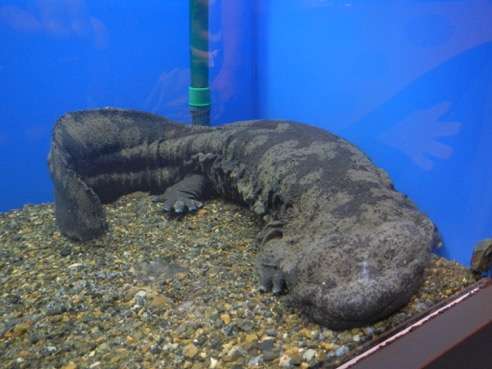Estimating the distribution of rare endemic and related exotic giant salamander species

A research group has succeeded in determining the habitat distribution of the Japanese giant salamander (Andrias japonicus), a designated special natural monument of Japan, and the distribution of a related exotic or invasive species, the Chinese giant salamander (Andrias davidianus). The team determined this information from salamander DNA that is naturally floating in river water (environmental DNA). The results of their research were published online on the British science journal named Journal of Applied Ecology on February 13, 2015, The essential points of their study are as follows:
Points
- Only four liters of river water are required to determine the distribution of giant salamander species.
- This is the first outdoor research study in Japan that covered a wide geographical region in a continuous manner using the environmental DNA analysis method.
- They succeeded in distinguishing the DNA of Japanese giant salamanders from that of Chinese giant salamanders, a closely related exotic species.
- Future surveys have been planned in other parts of the country.
The Japanese giant salamander (Andrias japonicus)
The research group led by Project Assistant Professor Dr. Minamoto focused on analyzing the DNA floating in environmental water (river or lake water) from pieces of skin and bodily excretions of fish and amphibians. They have developed a method to detect and amplify this DNA with high specificity using real-time polymerase chain reaction (PCR), typically fish species with a relatively high number of individuals present in the sampled habitat, such as bluegill or common carp. This method can therefore be used to determine the habitat distributions of aquatic creatures.
The Chinese giant salamander (Andrias davidianus)
Dr. Minamoto's group has succeeded in applying this method to the estimation of the habitat distribution of the Japanese giant salamander, a designated special natural monument, and a related exotic species, the Chinese giant salamander. The group conducted four water-sampling surveys at 37 points covering the entire Katsura River basin located in Kyoto Prefecture, Japan over a one-year period between 2012 and 2013. They attempted to detect the DNA of both giant salamander species in the four liters of water they sampled at each point and obtained a result that corresponded closely to those obtained from past capture surveys. This was the first time that the result of a study relying on extensive and continuous use of this environmental DNA method was published. This approach is likely to be useful for studying rare nocturnal species that are difficult to study using capture surveys.
More information: "A basin-scale application of environmental DNA assessment for rare endemic species and closely related exotic species in rivers: a case study of giant salamanders in Japan." DOI: 10.1111/1365-2664.12392
Journal information: Journal of Applied Ecology
Provided by Kobe University
















